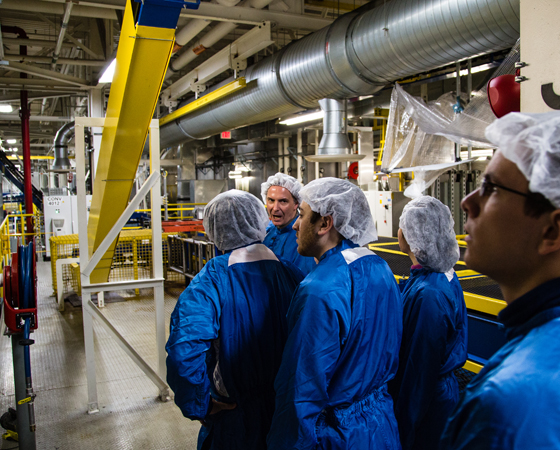GM Industrial Energy Efficiency Team Visits the Orion Plant in Detroit
By Kate MacAdam, Kunyao Yu, Jingwei Deng, and Mark Gockowski
Kate MacAdam:
On the Monday before classes began, our Bass Connections group flew to Detroit to get started on a project on energy efficiency in the automotive manufacturing industry. Three of us (including myself) just joined the project this semester, so it was the first time we had met as a team. Jeffrey Johnson, our General Motors company mentor, welcomed four of us at the airport. We braved the icy conditions and temperatures around -10°F on our way to the GM Technical Center. At GM, we were introduced to Al Hildreth, GM energy manager, who spoke with us about energy usage at GM plants across the world and how energy goals are incorporated into GM’s business plan. Jeffrey walked us through the details of our project—creating an updated and comprehensive model to predict energy usage in the GM paint shop. The next day we were given a behind-the-scenes tour of the paint shop in order to get a sense of how the processes work and how energy is utilized to paint cars. We wrapped up the visit with a tour of the general assembly before heading to the airport. Despite flight cancellations and a few bumps in the road, we were able to return to campus in time to start classes on Wednesday.
Kunyao Yu:
Our Bass Connections trip to the GM plant in Detroit helped us greatly in preparing for this upcoming semester. We were able to set project goals with our mentor, strengthen a newly formed team, and learn an incredible amount about the automotive manufacturing process. Most importantly, we were able to experience a GM paint shop rather than simply analyze it on paper. So far, our paint shop knowledge has been limited to what we’ve read in papers and watched in videos. On our tour of the paint shop and the assembly plant, we were able to see the different components of the paint shop process, the meticulous efforts of GM workers at each step of the process, and the advanced machinery used for various tasks. This was an eye-opening experience which will definitely benefit the team as we start to dig deeper into our study of paint shop energy efficiency.
Jingwei Deng:
A few days prior to the beginning of the spring semester, the Bass Connections team traveled to Detroit and was immersed in the workings of the Motor City as well as the snow that came with it. The General Motors plant visit was intended to introduce and familiarize us to the type of work we will be doing once back at Duke. Over the course of a day and a half, a brief technical training was conducted, project goals were developed, and a tour of the paint and assembly facility was accomplished. The experience as a whole was an excellent learning experience given that most of the members of the team had not been inside an automotive assembly plant prior to this. In addition, the visit provided the necessary background in to the energy efficiency analysis that will be conducted over the course of the semester. This project will definitely provide the kind of first-hand industry experience that goes beyond the classrooms so I am certainly looking forward to working with my multidisciplinary team and our GM company mentor Jeffrey Johnson.
Mark Gockowski:
I was impressed with a variety of different things during our team’s visit to GM’s Orion Assembly Plant. First was our GM mentor, Jeffrey Johnson. Not only does he have the technical expertise that comes with years of industry experience, but he is also a long time resident of the Detroit area and was thus an excellent tour guide. During our drives around town he dished out innumerable quirky facts about Detroit that made the trip much more enriching for me. As far as the actual technical aspect of the trip, I was impressed by how much effort GM puts into reducing its energy usage and carbon output despite the fact that those reductions do very little to decrease their total costs. Al Hildreth said it best when he said that saving a million dollars on energy in production will not decrease the price for which they sell their cars. Once we actually got to the plant, I was amazed by the sheer magnitude of the thing — they were aiming to assemble approximately 300 cars in just one shift. Again, Jeffery did an excellent job of guiding us through the assembly plant and explaining to us where and why energy is consumed in largest quantities and how our energy model could be used to build more efficient plants in the future. I think the opportunity to see first hand the process that we are attempting to model will be invaluable going forward with this research project.
